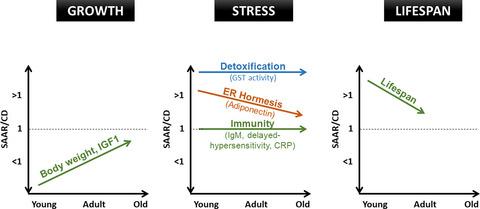当前位置:
X-MOL 学术
›
Aging Cell
›
论文详情
Our official English website, www.x-mol.net, welcomes your feedback! (Note: you will need to create a separate account there.)
Age-at-onset-dependent effects of sulfur amino acid restriction on markers of growth and stress in male F344 rats.
Aging Cell ( IF 7.8 ) Pub Date : 2020-06-22 , DOI: 10.1111/acel.13177 Sailendra N Nichenametla 1 , Dwight A L Mattocks 1 , Virginia L Malloy 1
Aging Cell ( IF 7.8 ) Pub Date : 2020-06-22 , DOI: 10.1111/acel.13177 Sailendra N Nichenametla 1 , Dwight A L Mattocks 1 , Virginia L Malloy 1
Affiliation

|
Trade‐offs in life‐history traits are clinically and mechanistically important. Sulfur amino acid restriction (SAAR) extends lifespan. But whether this benefit comes at the cost of other traits including stress resistance and growth is unclear. We investigated the effects of SAAR on growth markers (body weight, IGF1, and IGFBP3) and physiological stresses. Male‐F344 rats were fed control (0.86% Met) and SAAR (0.17% Met) diets starting at 2, 10, and 20 months. Rats were injected with keyhole‐limpet‐hemocyanin (KLH) to measure immune responses (anti‐KLH‐IgM, anti‐KLH‐IgG, and delayed‐type‐hypersensitivity [DTH]). Markers of ER stress (FGF21 and adiponectin), detoxification capacity (glutathione [GSH] concentrations, GSH‐S‐transferase [GST], and cytochrome‐P450‐reductase [CPR] activities), and low‐grade inflammation (C‐reactive protein [CRP]) were also determined. SAAR decreased body weight, liver weight, food intake, plasma IGF1, and IGFBP3; the effect size diminished with increasing age‐at‐onset. SAAR increased FGF21 and adiponectin, but stress damage markers GRP78 and Xbp1s/us were unchanged, suggesting that ER stress is hormetic. SAAR increased hepatic GST activity despite lower GSH, but CPR activity was unchanged, indicative of enhanced detoxification capacity. Other stress markers were either uncompromised (CRP, anti‐KLH‐IgM, and DTH) or slightly lower (anti‐KLH‐IgG). Increases in stress markers were similar across all ages‐at‐onset, except for adiponectin, which peaked at 2 months. Overall, SAAR did not compromise stress responses and resulted in maximal benefits with young‐onset. In survival studies, median lifespan extension with initiation at 52 weeks was 7 weeks (p = .05); less than the 33.5‐week extension observed in our previous study with 7‐week initiation. Findings support SAAR translational studies and the need to optimize Met dose based on age‐at‐onset.
中文翻译:

硫氨基酸限制对成年F344大鼠生长和应激标志物的年龄依赖性。
生命历史特征的折衷在临床和机械上都很重要。硫氨基酸限制(SAAR)可延长使用寿命。但是,这种好处是否以其他特征为代价,包括抗压力和生长尚不清楚。我们调查了SAAR对生长标志物(体重,IGF1和IGFBP3)和生理压力的影响。从第2、10和20个月开始,对雄性F344大鼠进行对照(0.86%Met)和SAAR(0.17%Met)饮食。给大鼠注射匙孔血蓝蛋白(KLH)以测量免疫反应(抗KLH-IgM,抗KLH-IgG和迟发型超敏性[DTH])。内质网应激(FGF21和脂联素),解毒能力(谷胱甘肽[GSH]浓度,GSH-S-转移酶[GST]和细胞色素P 450)的标记还确定了还原酶[CPR]活性和低度炎症(C反应蛋白[CRP])。SAAR降低了体重,肝脏重量,食物摄入量,血浆IGF1和IGFBP3;随着发病年龄的增加,效应大小减小。SAAR增加FGF21和脂联素,但应激损伤标记物GRP78和Xbp1 s / us均无变化,表明ER应激是恶性的。尽管GSH降低,但SAAR仍提高了肝脏GST活性,但CPR活性未改变,表明排毒能力增强。其他压力指标未受损(CRP,抗KLH-IgM和DTH)或略低(抗KLH-IgG)。除了脂联素在2个月达到峰值外,所有年龄段的应激标志物的增加都相似。总体而言,SAAR不会损害压力反应,并能在年轻患者中获得最大收益。在生存研究中,从52周开始的平均寿命延长为7周(p = .05);少于我们先前研究中观察到的33.5周延长(开始7周)。研究结果支持SAAR转化研究,并支持根据发病年龄优化Met剂量。
更新日期:2020-06-22
中文翻译:

硫氨基酸限制对成年F344大鼠生长和应激标志物的年龄依赖性。
生命历史特征的折衷在临床和机械上都很重要。硫氨基酸限制(SAAR)可延长使用寿命。但是,这种好处是否以其他特征为代价,包括抗压力和生长尚不清楚。我们调查了SAAR对生长标志物(体重,IGF1和IGFBP3)和生理压力的影响。从第2、10和20个月开始,对雄性F344大鼠进行对照(0.86%Met)和SAAR(0.17%Met)饮食。给大鼠注射匙孔血蓝蛋白(KLH)以测量免疫反应(抗KLH-IgM,抗KLH-IgG和迟发型超敏性[DTH])。内质网应激(FGF21和脂联素),解毒能力(谷胱甘肽[GSH]浓度,GSH-S-转移酶[GST]和细胞色素P 450)的标记还确定了还原酶[CPR]活性和低度炎症(C反应蛋白[CRP])。SAAR降低了体重,肝脏重量,食物摄入量,血浆IGF1和IGFBP3;随着发病年龄的增加,效应大小减小。SAAR增加FGF21和脂联素,但应激损伤标记物GRP78和Xbp1 s / us均无变化,表明ER应激是恶性的。尽管GSH降低,但SAAR仍提高了肝脏GST活性,但CPR活性未改变,表明排毒能力增强。其他压力指标未受损(CRP,抗KLH-IgM和DTH)或略低(抗KLH-IgG)。除了脂联素在2个月达到峰值外,所有年龄段的应激标志物的增加都相似。总体而言,SAAR不会损害压力反应,并能在年轻患者中获得最大收益。在生存研究中,从52周开始的平均寿命延长为7周(p = .05);少于我们先前研究中观察到的33.5周延长(开始7周)。研究结果支持SAAR转化研究,并支持根据发病年龄优化Met剂量。



























 京公网安备 11010802027423号
京公网安备 11010802027423号